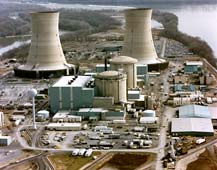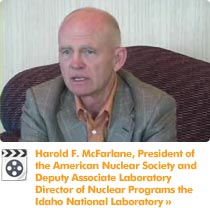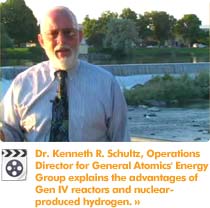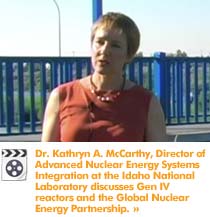

By Dean Stanley
IDAHO FALLS, Idaho -- Depending on who you talk to, the future of nuclear energy ranges from downright bleak to incredibly bright. Not surprisingly, the nuclear energy community -- both industry and academia -- are the ones wearing the sunglasses.
As part of General Motors’ Hydrogen Pathways program, experts in the field presented their case for nuclear energy and its role within the future hydrogen economy. What they describe is an industry on the verge of a renaissance, with great hopes for solving much of the world’s future energy needs.
As a key element of this enthusiastic future, the potential for nuclear-generated hydrogen may just be the solution required to create an economically viable commercial fueling infrastructure. GM and other automakers are looking for this kind of large-scale production capability as a way to ensure the needed hydrogen supply will be ready to support a growing fuel cell vehicle market.

Within several decades, fuel cell vehicles like the Chevrolet Sequel could be running on hydrogen produced at nuclear power plants.
“At GM, we believe that achieving truly sustainable transportation will be enabled by fuel cells and by hydrogen,” says Julie Beamer, GM’s director of fuel cell commercialization. “We see hydrogen as a long-term, very viable automotive fuel.” “What’s of interest to us in nuclear is a source, potentially, for the production of hydrogen,” Beamer explains. “There really is a critical need for the industry -- and the major economies around the world -- for secure and clean sources of energy.”
“We can’t continue to depend upon petroleum to supply 98 percent of the energy that’s used to fuel our vehicles,” Beamer states. “It’s just not sustainable.” Nuclear power does promise a vast, carbon-free source of electricity and hydrogen, though getting there will take time, not only from a technology standpoint, but from that of social acceptance -- one of the biggest questions still haunting the nuclear power industry is that of safety.
How Safe?
“The burning question that all of us have relative to nuclear: Is it safe -- not only for the communities, but for the employees?” asks Beamer. “And will society here in the United States be accepting of nuclear as a major source of power generation?”
 The partial core meltdown at Three Mile Island was the worst commercial reactor accident in U.S. history. Even so, the nuclear industry is quick to point out that there were no fatalities as a result.
The partial core meltdown at Three Mile Island was the worst commercial reactor accident in U.S. history. Even so, the nuclear industry is quick to point out that there were no fatalities as a result.Tacit acceptance seems to have been confirmed over the years. With just over one hundred plants currently operating in the United States, nuclear power plants supply 20 percent of U.S. electrical power. And while the 1979 core meltdown at Three Mile Island in Pennsylvania put the brakes on large-scale expansion of nuclear power, the nuclear industry states firmly that no fatalities have ever been recorded as a result of commercial nuclear power plant operation in this country.
“The safety record here in the United States is excellent,” says Dr. Harold McFarlane, president of the American Nuclear Society and Deputy Associate Director of Nuclear Programs at the Idaho National Laboratories. “No one has ever been killed as a result of commercial nuclear power operation,” says McFarlane, adding, “The same cannot be said for fossil fuel plants.”
In fact, the nuclear industry boasts an admirable safety record, with accident rates much lower than that of office workers, according to McFarlane. “This is just part of the operating culture,” he explains, adding that the industry must continue to maintain the public trust. “If there is any public injury, it would be very disruptive to the expansion of nuclear power.”
One reason for the industry’s strong record is the economic incentive on the part of the nuclear operators to remain safe, says McFarlane. “Organizations like the Institute of Nuclear Power Operations bring a lot of peer pressure to make sure all of the plants are up to a very high standard,” McFarlane further explains, “This has made a lot of difference in not just the safety to the community, but to the operation of the plant -- the economic performance of the plant.”
Entire contents © 2006 Corland Publishing. Use of editorial content without permission is strictly prohibited. All Rights Reserved. Privacy Policy Legal Contact Us. Site developed by ICON.




